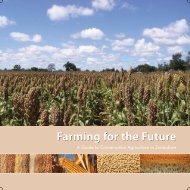Restoring the Soil - Canadian Foodgrains Bank
Restoring the Soil - Canadian Foodgrains Bank
Restoring the Soil - Canadian Foodgrains Bank
Create successful ePaper yourself
Turn your PDF publications into a flip-book with our unique Google optimized e-Paper software.
80Annex 2: The EvidenceFor example, smallholder farmers never do 15 replications of exactly <strong>the</strong> same experimenton one small piece of land. But if a technology is to <strong>the</strong> liking of <strong>the</strong> farmers,we may have hundreds of replications of very similar experiments, spread acrossdozens of soil types, topographies and different (though fairly similar) managementstyles. Ma<strong>the</strong>matically speaking, <strong>the</strong>se trials will give us a much better approximationthan will a scientific experiment of what will happen when o<strong>the</strong>r smallholder farmersreplicate that technology on <strong>the</strong>ir own farms. This better predictability from farmers’experiments occurs because a scientific experiment will normally include dozens ofreplications on fairly uniform micro-plots, carried out on one soil type (which usuallyhas a bizarre history of cultivation under past experiments), on flat land (hillsideexperimental stations are virtually nonexistent) and under only one standardized,and often very expensive, form of management. Each of <strong>the</strong>se conditions makes <strong>the</strong>scientific experiment less representative of <strong>the</strong> farmers’ conditions than do <strong>the</strong> farmers’experiments.Despite <strong>the</strong> informal nature of <strong>the</strong>ir experimentation, <strong>the</strong> varied trials smallholderfarmers do can be analyzed ma<strong>the</strong>matically to find out to what precise level of confidencewe can generalize <strong>the</strong>ir results across a wider population of farmers.I have not done any such analysis. I have visited <strong>the</strong> fields of thousands of farmers andseen <strong>the</strong> results. This book is a summary of what I have learned. The vast majority ofthis book’s content is based on those observations of individual fields and on conversationsI have had with <strong>the</strong> owners, plus conversations with dozens of <strong>the</strong> owners’neighbors and collaborators. It also includes observations of tens of thousands of o<strong>the</strong>rfields from moving vehicles.For agricultural extension purposes, most agricultural research in <strong>the</strong> world is donewith <strong>the</strong> purpose of trying to predict what technologies farmers will find beneficial,and will <strong>the</strong>refore adopt. When it comes to gm/ccs, we do not need to predict whatsystems farmers will adopt in <strong>the</strong> future. We already know what technologies <strong>the</strong>yhave adopted in <strong>the</strong> past. The only predictions needed are whe<strong>the</strong>r or not o<strong>the</strong>rfarmers working in similar conditions will act in <strong>the</strong> same way. This prediction is besttested by showing o<strong>the</strong>r farmers <strong>the</strong> results of <strong>the</strong> technology, and <strong>the</strong>n watching what<strong>the</strong>y do or don’t do with it.If we believe that farmers are, by and large, economically rational (given <strong>the</strong>ir ownpriorities), we don’t need to be guessing about whe<strong>the</strong>r <strong>the</strong> gm/cc technologies in thisbook will be beneficial to smallholder farmers under <strong>the</strong> conditions in which <strong>the</strong>y arebeing used. The very fact of widespread farmer use, given <strong>the</strong> assumption of farmerrationality, leads us to conclude that <strong>the</strong>se technologies are, in fact, benefiting <strong>the</strong>farmers.Still, some readers may have questions about issues that are more in <strong>the</strong> realm of <strong>the</strong><strong>the</strong>ory of soil fertility ra<strong>the</strong>r than farmer adoption of technology. I will refer to a fewof those questions and issues here.
















